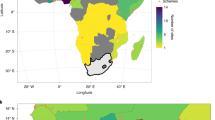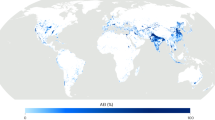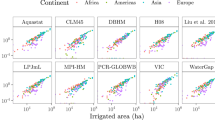Abstract
Irrigation expansion has been promoted as a way to improve global nutrition and health by increasing food production and income. However, its impact on the health and nutrition of local communities is unclear and might vary substantially across contexts, depending on who reaps the benefits and how. Here we combine georeferenced survey data from 9,144 rural communities (70,817 households) across 26 global south countries with data on global patterns of irrigation infrastructure changes to examine linkages between irrigation expansion and local changes in child diet diversity—a key indicator of micronutrient intake and development. We found a positive link between irrigation and child diet diversity, with substantial regional differences. Irrigation benefits were concentrated in regions without sufficient water resources to support it, suggesting trade-offs between dietary improvements and water stress. By contrast, irrigated areas with sufficient water tend to produce higher fractions of cash crops and export-oriented food items, with weaker associations to improved local diets. These findings suggest that while irrigation access is associated with overall improvements of child diet diversity in rural communities, water stress conditions can influence these outcomes. Nutrition-sensitive strategies thus need to be considered as an essential component of sustainable irrigation planning in the future.
This is a preview of subscription content, access via your institution
Access options
Access Nature and 54 other Nature Portfolio journals
Get Nature+, our best-value online-access subscription
$32.99 / 30 days
cancel any time
Subscribe to this journal
Receive 12 digital issues and online access to articles
$119.00 per year
only $9.92 per issue
Buy this article
- Purchase on SpringerLink
- Instant access to full article PDF
Prices may be subject to local taxes which are calculated during checkout



Similar content being viewed by others
Data availability
All data used in this study are publicly available via Zenodo at https://doi.org/10.5281/zenodo.6740334 (ref. 43) or from the corresponding author upon request.
Code availability
All code used in the study is publicly available via GitHub at https://github.com/piyushm9/IrrigationNutrition or upon request from the corresponding author.
References
FAO, IFAD, UNICEF, WFP & WHO. The State of Food Security and Nutrition in the World 2023: Urbanization, Agrifood Systems Transformation and Healthy Diets across the Rural–Urban Continuum (2023).
Arthur, S. S. et al. Tackling malnutrition: a systematic review of 15-year research evidence from INDEPTH health and demographic surveillance systems. Glob. Health Action 8, 28298 (2015).
UNICEF, WHO & World Bank. Levels and Trends in Child Malnutrition: UNICEF/WHO/The World Bank Group Joint Child Malnutrition Estimates: Key Findings of the 2021 Edition (2021).
Galway, L. P., Acharya, Y. & Jones, A. D. Deforestation and child diet diversity: a geospatial analysis of 15 sub-Saharan African countries. Health Place 51, 78–88 (2018).
Johnson, K. B., Jacob, A. & Brown, M. E. Forest cover associated with improved child health and nutrition: evidence from the Malawi Demographic and Health Survey and satellite data. Glob. Health Sci. Pract. 1, 237 (2013).
Rasolofoson, R. A., Hanauer, M. M., Pappinen, A., Fisher, B. & Ricketts, T. H. Impacts of forests on children’s diet in rural areas across 27 developing countries. Sci. Adv. 4, eaat2853.
Burney, J., Woltering, L., Burke, M., Naylor, R. & Pasternak, D. Solar-powered drip irrigation enhances food security in the Sudano–Sahel. Proc. Natl Acad. Sci. USA 107, 1848–1853 (2010).
Alaofè, H., Burney, J., Naylor, R. & Taren, D. Solar-powered drip irrigation impacts on crops production diversity and dietary diversity in Northern Benin. Food Nutr. Bull. 37, 164–175 (2016).
Burney, J. A. & Naylor, R. L. Smallholder irrigation as a poverty alleviation tool in Sub-Saharan Africa. World Dev. 40, 110–123 (2012).
Passarelli, S., Mekonnen, D., Bryan, E. & Ringler, C. Evaluating the pathways from small-scale irrigation to dietary diversity: evidence from Ethiopia and Tanzania. Food Secur. 10, 981–997 (2018).
Mekonnen, D. K., Choufani, J., Bryan, E., Haile, B. & Ringler, C. Irrigation improves weight-for-height z-scores of children under five, and women’s and household dietary diversity scores in Ethiopia and Tanzania. Matern. Child. Nutr. 18, e13395 (2022).
Jambo, Y., Alemu, A. & Tasew, W. Impact of small-scale irrigation on household food security: evidence from Ethiopia. Agric. Food Secur. 10, 21 (2021).
Balana, B. B. et al. Economic and food security effects of small-scale irrigation technologies in northern Ghana. Water Resour. Econ. 29, 100141 (2020).
Rosa, L., Chiarelli, D. D., Rulli, M. C., Dell’Angelo, J. & D’Odorico, P. Global agricultural economic water scarcity. Sci. Adv. 6, eaaz6031 (2020).
Müller, M. F. et al. Impact of transnational land acquisitions on local food security and dietary diversity. Proc. Natl Acad. Sci. USA 118, e2020535118 (2021).
Castet, A. The impact of large-scale land acquisitions on child food insecurity in Africa. World Dev. 179, 106597 (2024).
Chiarelli, D. D. et al. Competition for water induced by transnational land acquisitions for agriculture. Nat. Commun. 13, 505 (2022).
Deng, Q. et al. Deepening water scarcity in breadbasket nations. Nat. Commun. 16, 1110 (2025).
Usman, M. A. & Gerber, N. Assessing the effect of irrigation on household water quality and health: a case study in rural Ethiopia. Int. J. Environ. Health Res. 31, 433–452 (2021).
Usman, M. A. & Gerber, N. Irrigation, drinking water quality, and child nutritional status in northern Ethiopia. J. Water Sanit. Hyg. Dev. 10, 425–434 (2020).
Gerber, N. et al. Water, sanitation and agriculture linkages with health and nutrition improvement. SSRN https://doi.org/10.2139/ssrn.3455952 (2019).
Vangani, R., Saxena, D., Gerber, N., Mavalankar, D. & von Braun, J. Impact of different irrigation systems on water quality in peri-urban areas of Gujarat, India. SSRN https://doi.org/10.2139/ssrn.2816782 (2016).
Usman, M. A., Gerber, N. & Pangaribowo, E. H. Drivers of microbiological quality of household drinking water - a case study in rural Ethiopia. J. Water Health 16, 275–288 (2018).
Davis, K. F., Downs, S. & Gephart, J. A. Towards food supply chain resilience to environmental shocks. Nat. Food 2, 54–65 (2021).
Benson, T. Association between irrigated farming and improved nutrition in farm households in Malawi. Agrekon 54, 62–86 (2015).
Kafle, K., Omotilewa, O., Leh, M. & Schmitter, P. Who is likely to benefit from public and private sector investments in farmer-led irrigation development? Evidence from Ethiopia. J. Dev. Stud. 58, 55–75 (2022).
Pingali, P. Westernization of Asian diets and the transformation of food systems: implications for research and policy. Food Policy 32, 281–298 (2007).
Mehta, P. et al. Half of twenty-first century global irrigation expansion has been in water-stressed regions. Nat. Water 2, 254–261 (2024).
Steyn, N., Nel, J., Nantel, G., Kennedy, G. & Labadarios, D. Food variety and dietary diversity scores in children: are they good indicators of dietary adequacy? Public Health Nutr. 9, 644–650 (2006).
Kennedy, G., Ballard, T. & Dop, M. C. Guidelines for Measuring Household and Individual Dietary Diversity (Food and Agriculture Organization of the United Nations, 2011).
Niles, M. T. et al. Climate impacts associated with reduced diet diversity in children across nineteen countries. Environ. Res. Lett. 16, 015010 (2021).
Caswell, B. L., Talegawkar, S. A., Siamusantu, W., West, K. P. & Palmer, A. C. A 10-food group dietary diversity score outperforms a 7-food group score in characterizing seasonal variability and micronutrient adequacy in rural Zambian children. J. Nutr. 148, 131–139 (2018).
Hirvonen, K., Bai, Y., Headey, D. & Masters, W. A. Affordability of the EAT–Lancet reference diet: a global analysis. Lancet Glob. Health 8, e59–e66 (2020).
Herrero, M. et al. Innovation can accelerate the transition towards a sustainable food system. Nat. Food 1, 266–272 (2020).
World Health Organization. WHO Child Growth Standards: Length/Height-for-Age, Weight-for-Age, Weight-for-Length, Weight-for-Height and Body Mass Index-for-Age: Methods and Development (2006).
Center for International Earth Science Information Network (CIESIN). Gridded Population of the World, Version 4 (GPWv4): Population Density, revision 11 (2018); https://sedac.ciesin.columbia.edu/data/set/gpw-v4-admin-Unit-center-points-population-estimates-rev11/data-download
Center for International Earth Science Information Network (CIESIN) & Information Technology Outreach Services (ITOS), University of Georgia. Global Roads Open Access Data Set, version 1 (gROADSv1) (2013); https://sedac.ciesin.columbia.edu/data/set/groads-global-roads-open-access-v1/data-download
Meijer, J. R., Huijbregts, M. A. J., Schotten, K. C. G. J. & Schipper, A. M. Global patterns of current and future road infrastructure. Environ. Res. Lett. 13, 064006 (2018).
Florczyk, A. J. et al. GHS-UCDB R2019A – GHS Urban Centre Database 2015, multitemporal and multidimensional attributes. European Commission https://data.jrc.ec.europa.eu/dataset/53473144-b88c-44bc-b4a3-4583ed1f547e (2019).
Hansen, M. C. et al. High-resolution global maps of 21st-century forest cover change. Science 342, 850–853 (2013).
Gilbert, M. et al. Global distribution data for cattle, buffaloes, horses, sheep, goats, pigs, chickens and ducks in 2010. Sci. Data 5, 180227 (2018).
International Food Policy Research Institute. Global spatially-disaggregated crop production statistics data for 2010 version 2.0. Harvard Dataverse https://doi.org/10.7910/DVN/PRFF8V (2019).
Mehta, P. Global area equipped for irrigation dataset 1900-2015. Zenodo https://doi.org/10.5281/zenodo.6740334 (2023).
Acknowledgements
K.F.D. was supported by the United States Department of Agriculture National Institute of Food and Agriculture grant 2022-67019-368 37180. We would like to express gratitude to P. Mondal, C. Ringler and R. Vargas for their valuable feedback on the manuscript, which greatly contributed to its improvement.
Author information
Authors and Affiliations
Contributions
P.M. and K.F.D. conceived the study. K.F.D. coordinated the study. P.M., M.M. and K.F.D. designed all analyses. P.M. and K.F.D. collected the data. P.M. performed the analysis. P.M. and K.F.D. wrote the first draft. P.M., M.M., M.T.N. and K.F.D. contributed to manuscript writing and revision.
Corresponding authors
Ethics declarations
Competing interests
The authors declare no competing interests.
Peer review
Peer review information
Nature Sustainability thanks Nicolas Gerber, Giacomo Zanello and the other, anonymous, reviewer(s) for their contribution to the peer review of this work.
Additional information
Publisher’s note Springer Nature remains neutral with regard to jurisdictional claims in published maps and institutional affiliations.
Supplementary information
Supplementary Information
Supplementary Figs. 1–11 and Tables 1–15.
Rights and permissions
Springer Nature or its licensor (e.g. a society or other partner) holds exclusive rights to this article under a publishing agreement with the author(s) or other rightsholder(s); author self-archiving of the accepted manuscript version of this article is solely governed by the terms of such publishing agreement and applicable law.
About this article
Cite this article
Mehta, P., Muller, M., Niles, M.T. et al. Child diet diversity and irrigation expansion in the global south. Nat Sustain 8, 905–913 (2025). https://doi.org/10.1038/s41893-025-01584-y
Received:
Accepted:
Published:
Issue date:
DOI: https://doi.org/10.1038/s41893-025-01584-y



